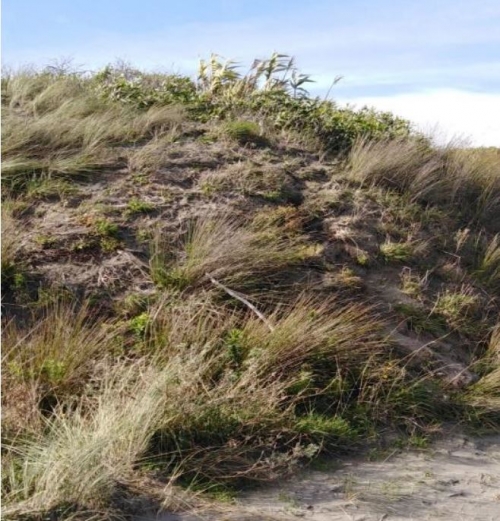Park Status: Open
Phragmites karka is also frequently known internationally as tall reed.
The Phragmites karka plant is frequently thought to be bamboo. This misperception has contributed to its rapid wide spread across the Manawatu region. People are unaware the plant spreading along the stop banks through estuaries in bog lands is not bamboo but potentially one of the biggest threats to the NZ landscape and ecosystems.
This reed grass has, on occasions, been used in other countries for weaving and thatching, but it is predominantly an invasive weed in most instances worldwide and definitely invasive in New Zealand.
P. karka creates large, in some cases many hectares of dense swathes of monoculture which crowds out other plant life. Our native plants and trees have no defences against his weed. They just get smothered by the reeds that cut out the light and the rhizomes crowd the roots out starving plants and even big trees of nutrients.
P.karka is found more frequently in wetlands, fore shore, river banks, stop banks and any general swamp or wet areas. It can survive and expand in dry areas and on hills providing moisture is available during the time it is getting established. It can survive in both fresh water and salt water, therefore our beaches and tidal estuaries are as at much risk as our inland waterways.
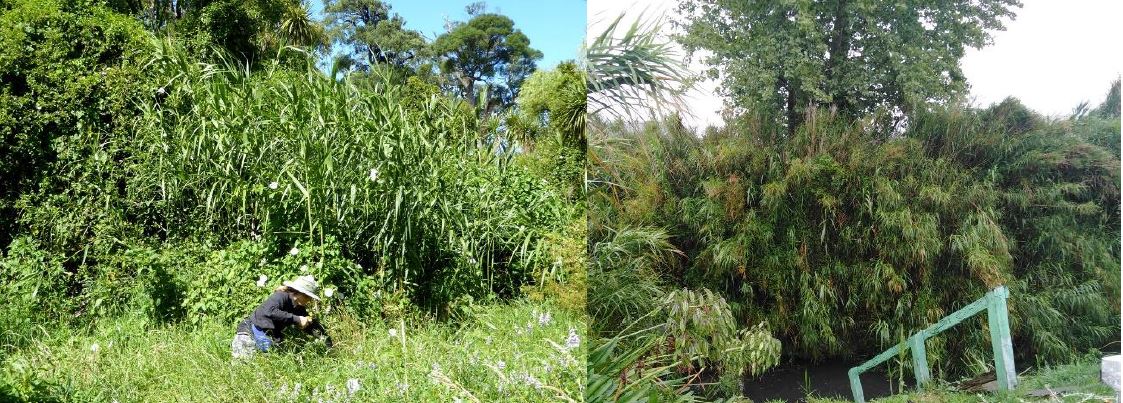
Phragmites karka was first identified in New Zealand in 2006 at Tangimoana, the Rangitikei River estuary. It was well established across the estuary when first recorded. It is unknown how long it has been in New Zealand or how it came into the country. The second recorded sighting was recorded in the Auckland Region in 2012. Now this weed is known to have invaded the last 3km of the Whangaehu River, 7km of the lower Rangitikei River, in the Makino stream from Feilding to the confluence of the Oroua River, down the Oroua almost to the Manawatu River. It is also found in the Horowhenua region in a number of sites. Two sites have in 2021 now also been recorded in the Kapiti area.
Phragmites karka has four parts to the plant, the reed, the stolon, the rhizome and small root structures.
Flowers/Seeds Phragmites karka has not formerly been knowns or observed in the Whanganui/Manawatu regions therefore it is not thought to be being spread by seed. It has been recorded flowering in the Auckland region.
The reed is the most visible part of the plant. This part can create new plants if broken off and it lands in water or on very wet ground. The nodes on the reed send out new roots into the ground and starts a new colony of Phragmites karkaThe rhizomes are not visible as they are under ground. These make up the majority of the plant biomass. These can get as thick at an adult’s wrist and have nodules or sections along their length. These can grow up to six meters a year underground sending up new reeds and forming big clumps. Any part of a rhizome broken off with a sectional nodule can form a new plant. When our rivers flow fast from rain and floods pieces of rhizomes break off and get carried to a new site downstream and establish new plants and colonies. The rhizome is the biggest spreader of this plant through fast underground growth and broken pieces in our waterways.
Roots are smaller than the rhizome and are not thought to able to reproduce if a piece is broken off.
Stolon are a bit like the reed and the rhizome combined. These can grow for five to six meters overland and put down roots creating new growth.
It is not known what are the best methodologies for manging the spread and invasion of this weed yet, particularly in sensitive ecosystems like waterways, swamps, native wetland forests etc
Trials are currently underway in AF/KP to find methods of control that don’t damage the existing environment with chemicals or large machinery trying to dig it out. You will see signs and patches of cut covered ad dried reeds across the park. These are trials plots looking at how we can manage this plant. Other trials work is being done in areas outside of the park by other entities. There is also a mapping program taking place to try and understand how far this weed has spread across the Region. Phragmites karka can be seen in the lower reaches of the Rangitikei and Whangaehu rivers, the Makino stream in Feilding, the Oroua river in patches, in the Horowhenua region and even down as far as Kapiti. It has been found on the foreshore around the Foxton area and on top of sand dunes at Tangimoana.
Prahmites Karka Management Report for 2024 - 2025
The 2024–25 Phragmites karka Management Report details the Green by Nature and Awahuri Forest Kitchener Park Trust’s efforts to control this invasive reed with support from Horizons Regional Council. Building on earlier research trials, the team refined and scaled up the “Cut and Inject” method, which continues to show strong results in reducing regrowth across multiple sites. In contrast, spray-based treatments proved ineffective and have been abandoned. While challenges remain around herbicide movement in underground rhizomes, successive treatments are significantly weakening infestations, giving new hope for long-term restoration of the forest and waterways.
See the detailed report by Barry Scott:
A monumental failure in weed pest management and control in the Manawatu-Whanganui region
Phragmites karka, or tall reed, is one of the most serious terrestrial weed pests to establish in New Zealand. It is unclear when it was introduced into New Zealand but retrospective identification confirmed it was growing as tall dense stands along the lower reaches of the Whangaehu and Rangitīkei Rivers in the 1980s. Later it was identified at several sites across Auckland. Once established it is very difficult to control as most standard herbicide treatments fail to kill it. It has slowly and silently spread from these early incursion sites to other waterways in the Manawatū–Whanganui region and, more recently, through flooding and storm surges, along the North Island western coast as far south as Kapiti. Nowhere has its impact been more noticeable than in the remnant lowland wetland podocarp forest of Awahuri Forest Kitchener Park (AFKP) near Feilding, where it has invaded following flood events and movement of reed, stolon and rhizome fragments from several heavily infected sites on the Makino Stream in the heart of Feilding. Besides its significant impact on natural ecosystems, it is also having serious economic impacts through blockage of streams and destabilisation of stopbanks. Surprisingly, it is not listed on the Ministry of Primary Industries (MPI) national weed pest register or on the Horizons Regional Council Pest Management Plan, yet its sister species, Phragmites australis, is listed as one of the most serious terrestrial weed pest species in New Zealand. While challenging to control, there is a need for a national or regional strategy to control further spread through more comprehensive surveillance, treatment at new detection sites, and through increased public awareness. With a lack of national and regional leadership, the response has been very ad hoc. Given the severity of its impact, the AFKP Trust has stepped in to fill this void by initiating research on control methods and organising workshops to raise community awareness. With recent support from the Horizons Biodiversity Fund the AFKP Trust has made significant progress in developing methods for controlling P. karka but more research and trials are needed, and urgently. Community groups and individuals have also taken the lead with surveillance, logging new infestations on iNaturalist, and being proactive in removal of this highly invasive weed at accessible sites along the coast. Without more action, Phragmites karka will continue to spread throughout the Manawatū-Whanganui region and further afield. Urgent leadership and action are needed.
Phragmites scale up R&D 2022 to 2024 final reports june 2024.pdf
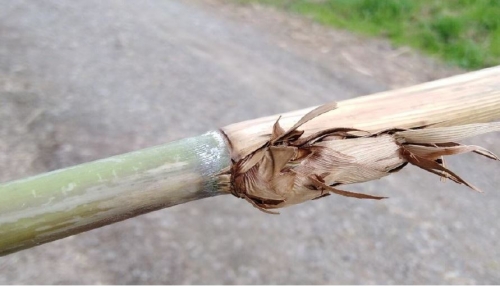
The reed is the most visible part of the plant.
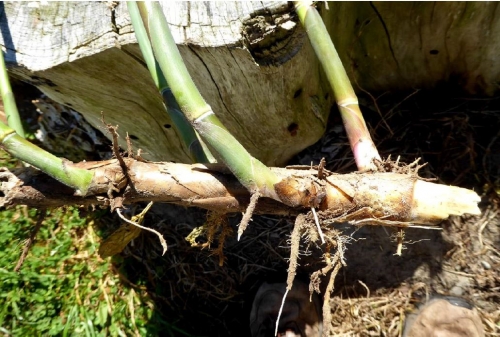
Phragmite roots are smaller than the rhizome and are not thought to able to reproduce if a piece is broken off.
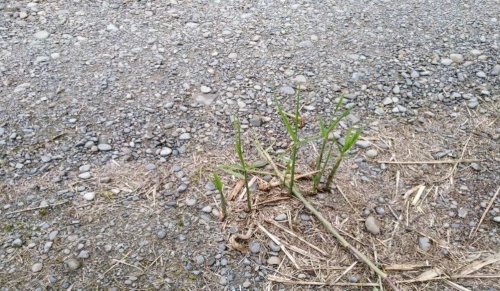
Stolon are a bit like the reed and the rhizome combined.
